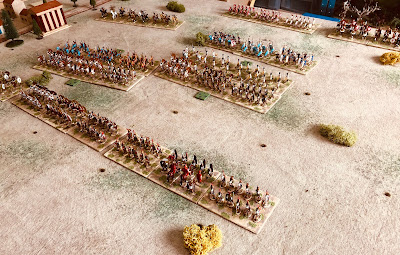Since my last post much of my wargaming time has been spent on English Civil War (ECW) gaming. All this ECW activity was due to the recent arrival of the book "With Pike and Musket" by C.F. Wesencraft. The book has many ECW battles described for wargaming and I chose the Battle of Ripple Field to recreate on the tabletop.
 |
| The deployment for one of the Battle of Ripple Field games |
I have played the game a few times this past week testing out a few rule modifications or tweaks to the D3 ECW rules I use, these are based upon the One Hour Wargaming rule set. I have yet to update the rules with my notes on the changes, but here is a quick summary of the changes I was trying out...
Activation Checks
I had used the activation check mechanism in some generic horse and musket rules a few weeks back (see here). I enjoyed how they added friction to the game as units accumulated more hits during the game. The changes below replaced the previous activation mechanism which was based upon the number of units within a certain distance of the commander.
The changed rule requires any unit trying to move, shoot, or melee to take an activation test to see if they are able to complete the order. In cases where a unit moves and shoots, or moves and melees, a unit will take multiple activation checks during a turn for each action. The activation check is quite straightforward, roll 2D6 and if the score is greater than the unit’s accumulated hits, the unit can complete the action. Otherwise, the unit cannot carry out the order, and in the case of a melee action a unit must retire half a move or rout in some cases (see below).
If a unit is within 12" of their commander they are allowed to re-roll a failed activation check. A commander is limited to attempting one re-roll every turn.
A score or 2 with the 2D6 will always be a failure, even if a unit has accumulated no hits.
 |
| A unit of dragoons with 4 hits successfully activates to shoot with a score of 7. |
Artillery Shooting
This rule change comes from the book "Charge". One of the reasons for changing from the previous approach where artillery roll D3-1 for hits every other turn, was to have a slightly different mechanism and also because I kept losing track of when artillery could shoot.
The changed mechanism allows artillery to shoot every turn (so no tracking required). Units may only shoot at a single unit directly in line with their frontal facing. This will cause artillery to pivot to select their targets and as a pivot counts as a move they will not be able to shoot in that turn. To check the range roll a D6 and multiply the score by 6” to determine the range**. If within range, a unit takes 1 hit.
**When shooting at units in cover, roll a D6-2 to determine the range.
 |
| An artillery unit will require a score of 4 on a D6 to cause 1 hit to the target infantry unit. |
Melee
The change to melee relates to the activation checks and in particular failed activation checks. All units that have moved into contact with an enemy unit, or are already engaged by an enemy unit, must engage in melee and must take an activation check first before checking for the number of hits inflicted.
A successful activation check allows a unit to engage in melee and determine the number of hits. When engaged with one enemy unit a failed activation check will cause the unit to retire half a move, still facing the enemy. If a unit is in melee with two enemy units and fails the activation check the unit routs and is eliminated.
With this rule, particularly the elimination when engaged with two enemy units, allows for the option to remove other flanking rule benefits.
 |
| An infantry unit with 6 hits is in melee with two cavalry units. It requires a score of 7 or more to activate. It fails with a score of 3 and will rout and be removed from play. If there was only one enemy unit, then the infantry unit would have retired half a move. |
Chance Cards
While not specifically part of the rules I have introduced chance cards. So far I have been using a simple set which allows units to rally off two hits, attempt an extra move or shoot, ignore activation check, ammunition resupply, confusion (which requires units wanting to move to activate on a 8+ regardless of hits), and out of ammunition (which requires units wanting to shoot to activate on a 8+ regardless of hits).
I now plan to adjust the cards to differentiate between a Parliamentarian army and Royalist army, so each has their own specific deck.
All being well I will be writing up the ECW D3 rules in the coming weeks.








































